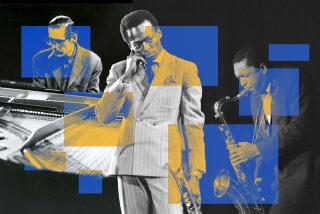Ives--Will He Have Staying Power This Time?
- Share via
From the late 1950s and Leonard Bernstein’s clarion labeling of Charles Ives as the Lincoln, Washington and Jefferson of American music (or words to that effect) to 1974, when the centennial of the composer’s birth was celebrated, Ives was a hero to the American musical establishment. How much of his music was actually listened to by the general public is open to question.
The plain fact of the matter was (and is) that while Ives’ cranky-Yankee personality proved most appealing, his music is for the most part tough stuff, oddly backward-looking in certain ways, “modern” with a vengeance in others.
Ives’ stock, eventually devalued by hype and the hucksters’ propounding of the notion that his music was all wacky fun, rose again last year with Deutsche Grammophon’s Grammy-winning Bernstein/New York Philharmonic recording of the Second Symphony, the same work and performers that triggered Ivesmania in the ‘50s with their CBS recording.
Perhaps Ives will stick this time and even achieve a wide, loyal audience. With more critical examination of his output, fixing on a few works rather than the odd-lot totality, he may make it. If he does, he can posthumously be grateful for the kind of masterful cause-pleading offered by conductor Michael Tilson Thomas and the Chicago Symphony Orchestra and Chorus with their recording of the First and Fourth symphonies (Sony Classical 44939).
Completing here his traversal of the five Ives symphonies (the unnumbered “Holidays” Symphony is actually a suite of short pieces), Tilson Thomas and his inspired colleagues, abetted by engineer Bud Graham’s superbly clarifying sonics, have achieved a recorded masterpiece.
The First Symphony, completed in 1898, Ives’s senior year at Yale, is a windily overreaching but endearingly tuneful homage to Dvorak and Wagner, with hints of the Ivesian fingerprints to emerge more clearly in the Second Symphony.
None of the several previous recordings of No. 1 have treated the score with the thoroughness and finesse shown by the present artists.
The much more prepossessing Fourth Symphony, completed in 1916 but not performed in its entirety until 1965, incorporates themes that Ives had been collecting for a quarter-century. At times it seems to sound them all simultaneously, as if to illustrate the outer limits of polytonality and polyrhythmicality.
Tilson Thomas and the Chicagoans project the Fourth Symphony’s mystery and majesty while untangling (but no more than necessary) the complex contrapuntal webs at the heart of its fascination.
Sony rounds out the program with what is in effect a Fourth Symphony study guide: handsomely forthright performances by Margaret Hillis’ Chicago Symphony Chorus and organist Richard Webster of the half-dozen hymns Ives quotes in the symphony.
Ives’ Second String Quartet (1907-1913) stands in the same relationship to the First Quartet (1896) as the Fourth Symphony does to the Second Symphony (1900-1902), in view of the latter’s mixing of late-Romantic European styles with American folk songs and Protestant hymn-tunes.
The First Quartet is calm, contemplative and tonal, the Second a dense, deep, seemingly chaotic challenge to its audience and to its performers, resembling nothing so much as a noisy argument in which each quartet member assumes, metaphorically, a dozen speaking, or shouting, parts.
(Note: In keeping with Ives’ notion that nothing simple had to remain that way, the composer rescored the finale of his First Quartet to serve as the dauntingly intricate finale of the Fourth Symphony.)
The Massachusetts-based Lydian String Quartet takes the measure of both works superbly (Centaur 2069). It does not underline the differences between the two, leaving that to Ives. Both are played with supreme technical command and sweetness of tone by this brainy ensemble.
Centaur offers a couple of Ives miniatures as bonuses: the 1904 “Hymn” and the delectably raucous “Hallowe’en” (1906).
A third major Ives chamber work is the 1911 Piano Trio, another of his tougher pieces, with its crazed chromatics and wild juxtapositions. The Fontenay Trio, the extravagantly gifted German ensemble that seems poised to assume the mantle of the aging Beaux Arts Trio, plays the work as if the performers had lived with it, and on the banks of the Housatonic, all their young lives (Teldec 244 924).
The Fontenay’s choice of coupling, Brahms’ familiar B-major Trio, Opus 8, which some might consider an Ivesian joke in itself, is in fact apt, considering Ives’ Romantic roots.
More to Read
The biggest entertainment stories
Get our big stories about Hollywood, film, television, music, arts, culture and more right in your inbox as soon as they publish.
You may occasionally receive promotional content from the Los Angeles Times.










